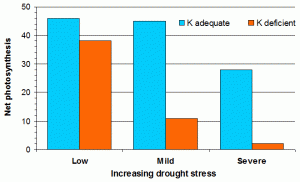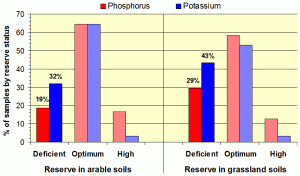Download pdf: Good soil potash reserves are required for efficient nitrogen use (174.24K)
pdf 174.24K
Good soil potash reserves are required for efficient nitrogen use
March 2012
In the spring there is understandably much talk of nitrogen applications, growth regulators and how well crops have come through the winter. It is seldom accompanied by discussion of the importance of potash on the efficiency of nitrogen utilisation, on the ability of cereal crops to resist going down, or on the resistance of the crop to abiotic stress.
Potash plays a critical role in all of these, with an adequate supply being essential to profitable crop performance. A Technical Topics booklet describes in detail the importance of potash on efficient nitrogen uptake and the effect on yield of potash deficiency. The quantity of potash required by crops is almost directly related to the green biomass, and winter cereals or rape will probably contain over 300 kg K2O/ha in the growing crop. This is considerably more than is recommended as a normal application for these crops, which is based only on the quantity removed at harvest. Most of the potash in the crops will have to come from the soil reserve, as measured by soil analysis. Uptake during stem extension can be as much as 10 kg K2O/ha per day and the soil must be able to release this potash from the potassium exchange sites on the clay and organic matter. If the soil cannot supply at this rate, or provide the total quantity of potash required by a crop growing to maximum potential, then the full expected yield is unlikely to be achieved.
It is for this reason that soil reserves of at least Index 2 for potassium are recommended. At this level of available reserve, there is little risk that the yield potential of the crop will be compromised; the nitrogen rate that is applied in anticipation of this yield will be efficiently and cost-effectively utilised. Furthermore the stress effects caused by a deficiency of potash which were discussed in an earlier PDA Newsletter will be avoided when soil reserves are adequate. Illustrations of the effect of potash in mitigating the stress effects of cold on oilseed rape and drought on wheat are shown again:

| Protection against frost damage on winter oilseed rape by an adequate supply of potash. | |||
| Potash rate
kg K2O/ha |
Cold damaged plants % |
||
| 0 | 61.7 | ||
| 75 | 35.0 | ||
| 225 | 19.0 | ||
| 450 | 7.5 | ||
| Ref: Australian Soil Fert. Manual (2006). | |||
In view of the clear negative effects of a shortage of available potash it is of considerable concern that on average for the last three seasons, about 32% of the arable soils in the UK are reported by PAAG to have inadequate potash reserves, with K Indices of 0 or 1. Grassland soils show an even greater potassium deficiency at 43% (see chart below). The situation with phosphorus is somewhat less severe, with about 19% of arable soils and 29% of grassland soils being at phosphorus Index 0 or 1, (See PAAG Annual UK Soil Analysis Results Reports).

Potash applied to a crop being grown in a deficient soil is unlikely to be able to compensate fully in the year of application for the shortage of potassium in the reserve. However a top-dressing of potash in the spring in these circumstances can help towards achieving the intended yield; this is particularly so on light soils.
Crops which are harvested green not only take up similarly large amounts of potash as they grow, but still contain it when they are harvested so that large quantities are removed from the field. This is the case for silage grass for example, where a good cut is likely to remove more than 200 kg K2O/ha; a similar quantity will be removed by whole-crop wheat. Potatoes are another crop where a high fresh weight is harvested, and with the tubers containing about 5.8 kg K2O/tonne when lifted, about 290 kg K2O/ha will be contained in a 50 tonne crop (see Nutrients in crop material: Phosphate and Potash Removal by Crops). This potash removal by potatoes has to be added to that which will have been in the above-ground leaves and stems in order to estimate the full uptake requirement of the crop.
As has been discussed in earlier Newsletters this high requirement for potash is needed in the cell sap so that the cells take in water by osmosis to remain turgid, so supporting the leaves. As the leaves of cereals and rape senesce, the cell walls rupture and some of the potash will be washed back to the ground by rain, or will be available from the straw if incorporated. If the straw is removed however, the potassium remaining in the dry leaf and stem cells will stay with the straw, providing a useful source of available potash for those who buy the straw.
Crops will contain considerably more potassium than nitrogen, and if the amount of potash they can find in the soil is insufficient they will simply limit their growth. Deficiency symptoms may not be seen; the crop will just not achieve its full potential and other inputs will be wasted.

